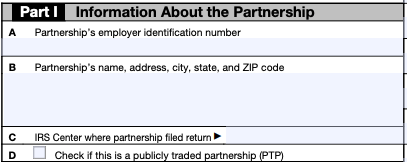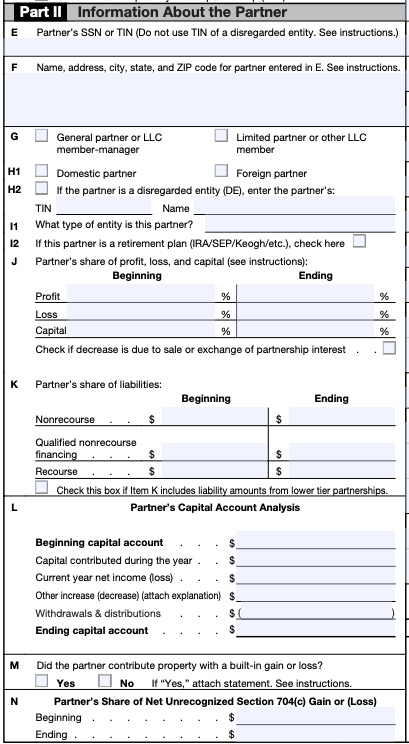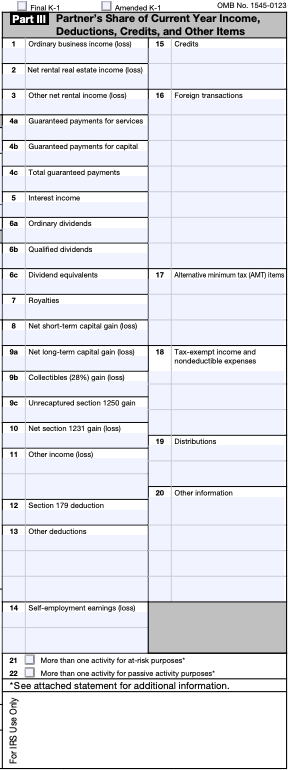Where Do You Enter Schedule K-1 Box 17 Code Ac
What is Schedule K-1?
Schedule K-1 is a schedule of IRS Form 1065 that members of a business partnership use to report their share of a partnership's profits, losses, deductions and credits to the IRS.
You'll fill out Schedule K-1 as part of your Partnership Tax Return, Form 1065, which reports your partnership's total net income.
Because partnerships are so-called "pass-through" entities—they let the profits or losses of a business "flow through" to its owners without paying corporate taxes—Schedule K-1 is an important part of the partnership tax return process. It helps you and the IRS figure how big your piece of the pie is in the partnership, and how much of the partnership's income (or losses) you should actually report on your personal tax return.
Where can I find a sample K-1 tax form?
You can download a sample copy of Schedule K-1 (Form 1065) from the IRS.
But you'll probably receive a copy of Schedule K-1 around tax time from your accountant or whoever is responsible for filing your partnership's Form 1065.
Remember that the IRS won't accept your personal tax return (Form 1040) if it doesn't have a Schedule K-1 attached.
Who has to file it?
If you're part of a:
- general partnership
- limited partnership
- limited liability partnership
- LLC that has elected to be taxed as a partnership
You need to do at least two things during tax season:
-
Make sure your partnership has filed a Partnership Tax Return, Tax Form 1065
-
File your own individual Schedule K-1
Not sure whether you're in a partnership? Here are some telltale signs:
-
You co-own a business with one or more person, but that business isn't incorporated. (Remember: you don't need to file any forms with your state to start a partnership. All you need is a verbal agreement.)
-
You've signed a partnership agreement and registered the partnership with the state.
-
Your company is an LLC and has not decided to be taxed as a corporation this year. (That is, it hasn't filed Form 8832.)
There are actually two more forms that the IRS calls 'Schedule K-1':
-
Schedule K-1 of Form 1041, which must be filed by beneficiaries of trusts or estates
-
Schedule K-1 of Form 1120S, which must be filed by the owners of S corporations
Although these forms are similar, in this guide we'll focus exclusively on Schedule K-1 of Form 1065, to be filed by partnerships.
K-1 distribution
The profits of a partnership are distributed according to the partnership agreement created by each of the partners. In other words, each partnership decides for itself how it will distribute earnings.
Even if a partnership has not distributed any cash to the partners, the partners will be allocated their share of the overall partnership income or loss.
K-1 vs 1099
Your partnership receives 1099 forms from your clients if they paid you more than $600 during the year. When you add up the total income from all the 1099s, you will get most (but not all) of the income earned by the partnership during the tax year. This information can be used to file your form 1065 on behalf of the partnership.
In other words, 1099 forms are relevant for reporting the income of the partnership as a whole. Schedule K-1 is relevant to the individuals of the partnership when reporting their share of the profit or loss. A partner will almost never receive a 1099 from the partnership that they own.
Self-employment tax K-1
Schedule K-1 will show you your self-employment earnings from the partnership or LLC you're a member of. So you will need to pay self-employment tax on that amount.
But, like anything IRS-related, there are a few exceptions.
What does it look like?
The PDF for Schedule K-1 of Form 1065 provided by the IRS is two pages long. The actual schedule is found on the first page, and the second page is devoted to a glossary of reporting codes you'll use in Part III of the form (more on that below).
The first page looks like this: 
How to read a K-1, Form 1065
Most of the information you'll need to complete your Schedule K-1 will come from the Income and Expenses section of Form 1065.
Beyond ordinary business income (or losses), Schedule K-1 also captures things like real estate income, bond interest, royalties and dividends, capital gains, foreign transactions, and any other payments that you might have received as part of your involvement in the partnership. You'll need that information on hand to fill out the form.
Part I. Information About the Partnership

Item A
Enter your partnership's Employer Identification Number (EIN) here.
Item B
Enter your partnership's contact information here.
Item C
Identify which IRS filing center you're sending Form 1065 to here. (If you're not sure where you're sending Form 1065 this year, consult this IRS chart.)
Item D
Check this box if your partnership is a publicly traded partnership (PTP), with shares that are bought and sold on an established securities market. (For more information about PTPs, see this guide from the IRS.)
Part II. Information About the Partner

Item E
Enter Your Taxpayer Identification Number (TIN)—which can be either your social security number (SSN), individual taxpayer identification number (ITIN), or employer identification number (EIN)—here. Read more about TINs on the IRS's website.
Items F-I
Enter your contact information, partner status, and whether you're a foreign or domestic partner here.
Item J
Here you'll report your share of the partnership's profits, loss, and capital. Generally speaking, these amounts are based on the business' partnership agreement.
If you entered the partnership after the beginning of this year's reporting period, you'll enter the percentages that applied to you when you entered in the 'Beginning' column. If you left the partnership before the end of the reporting period, you'll put the percentages that applied to you when you left in the 'Ending' column.
Item K
Here you'll enter your share of the partnership's liabilities (or debts), sorted by liability type: recourse, qualified nonrecourse, and recourse.
A recourse debt is a debt that holds the borrower personally liable (which means a lender can go after your property), while all other debt is considered nonrecourse. For more information about the difference, see the IRS's guide to recourse debt and the instructions to Schedule K-1.
Item L
Here you'll tell the IRS how much capital you had in the business at the beginning of the tax year, how much you put in during the year, whether your share of capital decreased or increased, any withdrawals or distributions you made, and how much capital you ended the year with.
Item M
Check "yes" here if you contributed property with a built-in gain or loss to the partnership this year. The IRS defines a built-in gain or loss as "the difference between the fair market value of the property and your adjusted basis in the property at the time it was contributed to the partnership."
Part III. Partner's Share of Current Year Income, Deductions, Credits, and Other Items
In this section you'll report your share of the partnership's income, loss, deductions, credits, and any other money you might have received in connection with your stake in the partnership.
To fill out boxes 11 and boxes 13 through 20, you'll need to use the codes located on page two of the Schedule K-1 form.

Box 1. Ordinary Business Income (Loss)
Enter your share of the ordinary income (loss) from trade or business activities of the partnership this year here.
Box 2. Net Rental Real Estate Income (Loss)
Enter your share of net rental real estate income (from renting housing, office space, retail space, and any other kind of real estate) from the partnership here.
Box 3. Other Net Rental Income (Loss)
Here you'll report your share of any other rental income you earned from the partnership.
Box 4. Guaranteed Payments
Here you'll report any guaranteed payments you received from the partnership. These are payments that the partnership made to you without regard to the partnership's income, usually in exchange for services or for the use of capital.
For more information about guaranteed payments and other kinds of payments partnerships make to their partners, see this guide from the IRS.
Box 5. Interest Income
Here you'll report any interest income you earned during the year, from things like bonds, certificates of deposit, bank accounts, etc.
Box 6. Dividends
Here you'll record any ordinary, qualified and dividend-equivalent payments you received from the partnership. (Dividends are payments that people get for holding shares in a company.)
Box 7. Royalties
Here you'll report any royalties you received during your dealings with the partnership.
Box 8. Net Short-Term Capital Gain (Loss)
Report any short-term capital gains (or losses) you sustained during your dealings with the partnership here.
Box 9a-c. Other Capital Gains (Losses)
This section is all about long-term gains or losses you sustained this year. For a detailed breakdown of which gains qualify as short and long term, see this guide from the IRS.
Box 10. Net Section 1231 Gain (Loss)
Section 1231 transactions involve the sale or exchange of property, leaseholds, cattle and horses, timber, coal, or iron ore, and other property. For a detailed discussion of Section 1231 transactions, consult page nine of the Schedule K-1 guide from the IRS.
Box 11. Other Income (Loss)
If you have any other losses or income to report that doesn't fall in the interest, ordinary dividends, royalties or capital gains category, report them here and attach a statement explaining what kind of income (or loss) you're reporting. The instructions to Schedule K-1 offer a detailed breakdown of what you could report here.
Box 12. Section 179 Deduction
If you're claiming the Section 179 deduction, report your share of that deduction here.
Box 13. Other Deductions
Here you'll use the codes on page 2 and the instructions to Schedule K-1 to report any other deductions you're claiming, including cash contributions, noncash contributions, educational assistance benefits, pensions and IRAs, and any other deductions you want to report.
Box 14. Self-Employment Earnings (Loss)
Use this box to report any self-employment earnings (or losses).
Box 15. Credits
Here you'll use the codes on page 2 and the instructions to Schedule K-1 to report your share of any credits you're claiming, including the low-income housing credit, the disabled access credit, the work opportunity credit, research activities credits, and any other credits.
Box 16. Foreign Transactions
If you do any business overseas, use this section to report your share of any income or losses you sustained in any foreign transactions you participated in.
Box 17. Alternative Minimum Tax (AMT) Items
Enter any Alternative Minimum Tax (AMT) information that might be applicable to you here. (Read more about the AMT in the instructions to Form 1040.)
Box 18. Tax-Exempt Income and Nondeductible Expenses
If you made any tax-exempt income or made any nondeductible expenses, report them here.
Box 19. Distributions
Report any distributions you received in the form of cash, marketable securities, or property, or any distributions subject to section 737 here.
Box 20. Other Information
Report any other information here using the codes on page 2 of Schedule K-1 and the instructions to Schedule K-1.
When are K-1s due?
The due date for Form 1065 is usually March 15 (unless you file for a 6-month extension using Form 7004). March 15 is also the deadline for partnerships to issue individual Schedule K-1s to each partner, which will give individual partners a little under a month to file their personal returns.
Calculating each partner's share of each Schedule K-1 item can be complex and time-consuming. We highly recommend that you hire an expert to help you file to make sure you get it in on time.
What's Bench?
We're an online bookkeeping service powered by real humans. Bench gives you a dedicated bookkeeper supported by a team of knowledgeable small business experts. We're here to take the guesswork out of running your own business—for good. Your bookkeeping team imports bank statements, categorizes transactions, and prepares financial statements every month. Get started with a free month of bookkeeping.
This post is to be used for informational purposes only and does not constitute legal, business, or tax advice. Each person should consult his or her own attorney, business advisor, or tax advisor with respect to matters referenced in this post. Bench assumes no liability for actions taken in reliance upon the information contained herein.
Where Do You Enter Schedule K-1 Box 17 Code Ac
Source: https://bench.co/blog/tax-tips/k1-tax-form/
0 Response to "Where Do You Enter Schedule K-1 Box 17 Code Ac"
Post a Comment